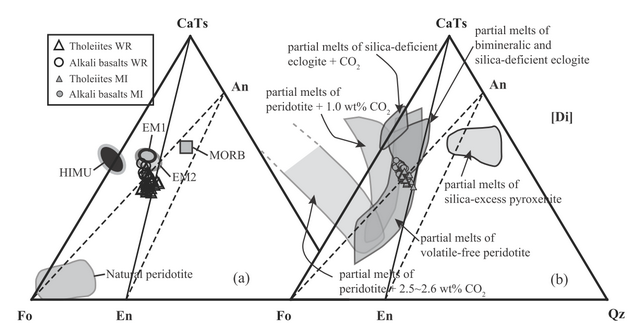
To date, a large number of studies on the origin of mafic volcanic rocks are based on the geochemical data of whole rocks. However, whole rocks record only a ‘mixture’ of compositions produced by complex petrogenesis involving partial melting in the mantle, magma mixing in magma chamber(s), assimilation during their ascent, and post-magmatic alteration. So specific information about the primary magma and nature of their source is retained in only a highly attenuated form or has completely disappeared from the geochemical data of whole-rocks. In contrast, melt inclusions ‘frozen’ in early crystallizing high-Fo olivines can provide important information on compositions of primary magmas before extensive magma mixing that may not always be available from whole-rock study.
Recently, Prof. REN Zhongyuan’s research team of the State Key Laboratory of Isotope Geochemistry, Guangzhou Institute of Geochemistry, Chinese Academy of Sciences, analyzed chemical data of olivine-hosted melt inclusions in Cenozoic basalts from the North Hainan Island and found both tholeiitic and alkalic melt inclusions in a single rock sample. On the bases melt inclusion and whole rock geochemistry of the Hainan basalts, they infer that a stage-2 silica-deficient pyroxenite derived from melt–peridotite reaction or mechanical mixing between recycled oceanic crust and peridotite can serve as the source lithology. The compositional range from tholeiitic to alkalic basalts is ascribed to decreasing degrees of melting of a similar silica-deficient pyroxenite source, which is consistent with the lower incompatible trace element and REE abundances in the tholeiites compared to the alkali basalts.
Both subalkaline and alkaline melt inclusions are present in a single sample, which indicates that magma mixing had occurred in the magma chamber that was supplied by high-Si melts and low-Si melts derived from different degrees of melting of a silica-deficient pyroxenite source. The result has been published in GCA.
Reference: Jian-Qiang Liu, Zhong-Yuan Ren*, Alexander R. L. Nichols, Mao-Shuang Song, Sheng-Ping Qian, Yan Zhang, Pei-Pei Zhao (2015). Petrogenesis of Late Cenozoic Basalts from North Hainan Island: Contraints from Melt Inclusions and Their Host Olivines. Geochimica Et Cosmochimica Acta 152, 89-121.

Fig. 1. Tholeiitic and alkalic melt inclusions are present in single alkalic (a and b) and tholeiitic (c and d) rock samples, which suggests that magma mixing has occurred in the magma chamber prior to eruption beneath Hainan island (Liu et al., 2015, GCA).

Fig. 2. Primary melt compositions of alkaline whole rocks and melt inclusions are almost nepheline-normative, which fall above the Fo-An join, while those of tholeiitic whole rocks and melt inclusions are almost hypersthene, which fall below the Fo-An join. Nevertheless, both tholeiitic and alkalic compositions plot on the silica-poor side of the thermal divide (CaTs-En join), similar to that of EM1-EM2 compositions (see text for further explanation) (Liu et al., 2015, GCA).

86-10-68597521 (day)
86-10-68597289 (night)

86-10-68511095 (day)
86-10-68512458 (night)

cas_en@cas.cn

52 Sanlihe Rd., Xicheng District,
Beijing, China (100864)

